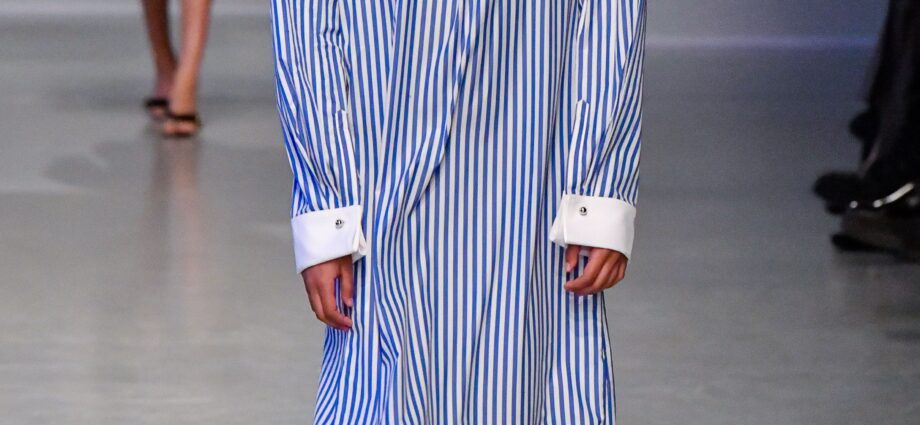For as long as I can remember, I’ve loved wearing things the ‘wrong’ way and repurposing non-traditional objects as outfits. Skirts as sleeveless dresses, necklaces as belts and vice versa, button-down tops backwards, wide belts as skirts, skirts over pants. I also have a penchant for Christmas ornaments as earrings, and antique miniature portraits meant for walls on chains as charms. There is nothing better to me than wearing vintage skinny belts (preferably by Whiting & Davis) as necklaces. But most of all: jackets, coats, shirts and dresses, inside out.
So, I was overjoyed when on the fall 2025 runways, more than one designer engaged in flipping the script on how we conventionally wear our clothes. Upside down, inside out, reversed and contorted. For the final of Yohji Yamamoto’s fall 2025 collection, a group of models emerged wearing long back jackets with brilliant royal purple accents. They paused for the audience to look on, as they swapped the garments and turned them literally inside out, helping each other along the way to reveal outfits that were entirely different from what they first wore. Yohji-San famously doesn’t do interviews unless they’re in-person, but via an email, he tells Vogue that the concept was about “perfection… imperfection… I think they are the same. They can switch. So I want to show both sides.”
He continues: “When you wear clothes in a different way, maybe you find something new. When you turn them inside out, you can see the construction. You see the truth. Sometimes this part is more beautiful.”
Yohji Yamamoto fall 2025 collection.Photo: Getty Images
Yohji Yamamoto fall 2025 collection.Photo: Getty Images
Likewise, the rising brand Zomer, run by Danial Aitouganov and Imruh Asha, kicked off its fall 2025 show backwards, with models taking their final walk first. They all wore pieces that were upside down, turned around, or purposely inverted. “It all began with a conversation between us, a shared desire to go back in time and redo things,” says Aitouganov. “That idea sparked our styling process, which then evolved into the design phase. Some pieces are intentionally designed to be worn back to front. They might look ‘wrong’ at first, but the fit is just right. And some items were styled specifically for the show.”
For Sarah Burton’s fall 2025 Givenchy debut, structured dresses looked like they had been intentionally designed to look backwards, revealing the flip side of a collar that may have been on the back. Similarly, sustainable designer Maria McManus had models wear outerwear inside out for the spring 2025 show, to show the otherwise hidden details like organic cotton lining, buttons made from biodegradable potato starch and corozo nuts, and expertly bound seams.
But the idea of backwards, inside out, and reversed clothes have existed in runway shows for decades now. Viktor & Rolf’s spring 2006 show began much like Zomer’s, with the designers taking their bow first, followed by a final walk, and upside down, inside out, sideways gowns. It’s a theme the designer duo would take on time and time again, most recently in the spring 2023 couture show. Demna’s opening look for Vetements’ fall 2018 show was an inside out fur coat.
Inside out clothes, however, have a much deeper, more obvious connection to fashion’s biggest deconstructists, like Yohji Yamamoto, and other household names including Maison Margiela, Comme des Garçons, and Ann Demeulemeester. Each of these houses and designers have experimented with outward seams and raw edges that play with deconstruction and the inner workings of clothing design since their inception. Donning something inside out brings little frays of fabric and inner stitchings to the surface, like softly whispered secrets revealed.
And wearing pieces inside out may just be the final frontier in fashion. It also allows for an oddly satisfying exploration that rarely exists in a world of overly curated, over-filtered imagery. During New York Fashion Week earlier this year, I paired a long cobalt blue Cecilie Bahnsen dress with a Noir Kei Ninomiya woven jacket worn inside out, so the bright orange lining of the sleeves showed instead of the usual forest green. Coats from Noir Kei Ninomiya and Junya Watanabe (both of the Comme des Garçons umbrella) are my favorites to wear inside out. Along with one of my favorite Prada gray leather coats, lined in Kelly green shearling, which I can’t help but reverse, especially with the pockets now on the outside. Bomber jackets and long, complicated coats with interesting stitching work best for inside out dressing. I’ve developed a method for hiding tags with safety pins too. Plus, there’s an added advantage: One coat can articulate two totally different looks.
Writer Kristen Bateman shows her inside out fashions at New York Fashion Week.Photographed by Phil Oh.
In a world of sameness, the idea of wearing something inside out feels like a small rebellion against conformity. “I don’t think there is a wrong way,” says Yohji-San. “Fashion has too many rules. But too many rules is boring. If you feel good, maybe it’s already correct. Wrong can be more real, more honest.”
Aitouganov affirms: “It’s more about questioning. Who made these rules anyway? You can do what you want. Wear it how you want.” There are a lot of ways in which the world is perceivably going backwards. Fashion may be reflective of that. Wearing one’s clothes with reckless abandon of rules feels like the secret to some small freedom.

